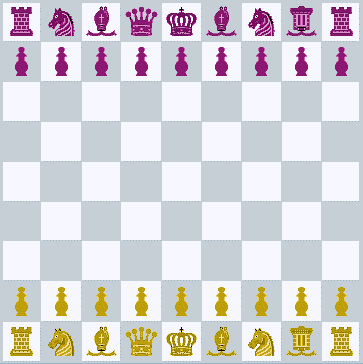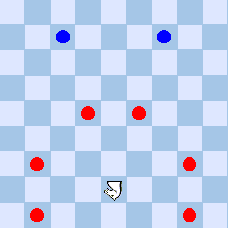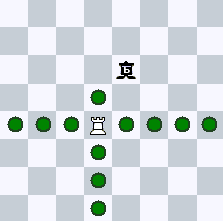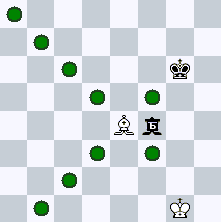

In Bodyguard Chess the pieces move as in orthodox chess, with the exception of the additional pieces, the Bodyguard and the Kvagga. The Bodyguard slides one or two steps in any direction. It has about the same value as a queen (my estimate). The Bodyguard can stymie the movement of enemy pieces. This implies that an enemy piece can only move one square at at time so long its movement occurs on the squares immediately surrounding the Bodyguard (an enemy Kwagga will lose its second leap). Unlike the Mongolian Bodyguard, this version is capable of checkmating the enemy king.
The Kwagga (striped horses above) moves like an extended knight, three squares orthogonally plus one step to the side. It can multiply this jump in the same direction. This means that the Kwagga moves like a Camelrider. However, unlike the Camelrider, the Kwagga can only capture on the first jump, and the next square must be empty. The Kwagga is as valuable as a bishop (my estimate). Due to the 9x9 board, castling is "long" on both sides.
Thanks to its stymieing capability the Bodyguard is immune against long-range attacks from enemy queen, rook, and bishop. This also means that these pieces cannot easily guard friendly pieces being threatened by an enemy Bodyguard. This makes the Bodyguard a very useful attacking piece in the middlegame. If the Bodyguard is placed centrally during the middlegame, it effectively stymies the long-range enemy pieces. The Kwagga, however, remains a serious threat to the Bodyguard. All other pieces must be positioned next to the Bodyguard if they are going to capture it.
The Kwagga's properties are very special. Like the bishop it always moves on the same square colour. On this board it can maximally make two jumps in the same direction. Thanks to its long leaps it can make threats behind the enemy lines. It can be a very irritating piece. It is much stronger and maneuverable than a Camel, and, since it cannot capture on the second leg, it is less brutal than a Camelrider. These properties make it an accessible piece, and its movement is not overly hard to calculate. It seems like its value is on a par with the bishop, regardless of board size. This is a great advantage compared with the knight. On a 10x10 board, the knight becomes significantly weaker than a bishop, something which complicates the strategical situation, and perhaps makes the game less accessible.
The Bodyguard piece derives from Hiashatar, a Mongolian variant. The only difference is that this very version is capable of checking and checkmating the enemy king. This, and the fact that the board is smaller than in Hiashatar, makes this version of the Bodyguard much more powerful. The kwagga (quagga), now extinct, was a mammal (Equus quagga) of southern Africa related to the zebras. In the kwagga, the striping was confined to the head, neck, and forequarters, the back being solid brown. Bodyguard Chess, and the new Kwagga piece, were invented by undersigned, November 2006.
Examples
 The Kwagga cannot capture on the blue spots (red = both movement and capture).
The Kwagga cannot capture on the blue spots (red = both movement and capture).
 This position is checkmate because the black queen is stymied by the white Bodyguard.
This position is checkmate because the black queen is stymied by the white Bodyguard.
 The rook's northward movement is stymied by the Bodyguard.
The rook's northward movement is stymied by the Bodyguard.
 The bishop's easthward diagonals are stymied by the Bodyguard. This means that the black king is not in check.
The bishop's easthward diagonals are stymied by the Bodyguard. This means that the black king is not in check.
• You can download my free Bodyguard Chess program here (updated 2006-11-23), but you must own the software Zillions of Games to be able to run it (I recommend the download version).
• Don't miss my other chess variants.
© M. Winther 2006